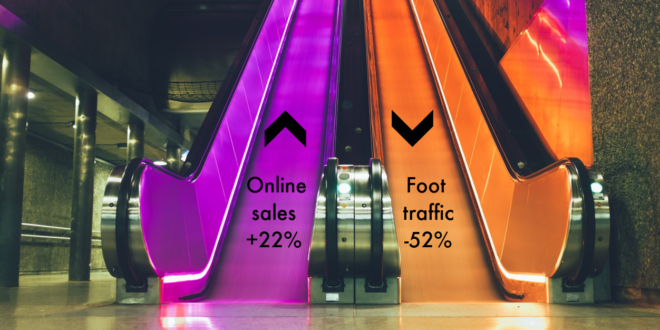By Jeff Domansky, Nov 30, 2020
Black Friday looked very different this year from previous years.
Initial results show US consumers shopped from their couches with a vengeance, racking up more than $9 billion in Black Friday purchases online.

During the pandemic, Thanksgiving Day shopping traffic plunged 94.9% as most large retailers closed to give their employees the day off. On Black Friday, in-store traffic dropped 52.1% according to Sensormatic Solutions, which said it also expects overall in-store foot traffic to drop by 22% during the holiday season.
“Due to COVID-19 and social distancing requirements, shoppers were more purposeful in their in-person Black Friday shopping, causing significantly less crowds than we’ve seen in the past,” said Brian Field, senior director of global retail consulting, Sensormatic Solutions. “This was compounded by retailers not offering as many in-store doorbusters and the increasing adoption of e-commerce.”
Online sales and in-store pickup jumped
The COVID-19 crisis had a predictable impact on initial holiday shopping with a 22% increase in online sales totaling an estimated $9.03 billion, according to Adobe Digital Insights. Black Friday sales started well in advance for some retailers with Digital Commerce 360 reporting 76% of the top 50 US retailers offering Monday pre-event sales.

Adobe said consumers spent $6.3 million per minute online, an average of $27.50 per person. Spending via smartphones continued to grow, jumping 25.3% compared to last year to reach $3.6 billion or 40% of total e-commerce spending.
According to Adobe research, the biggest sellers included Hot Wheels, Lego sets, AirPods, Apple Watches, Amazon Echo devices, and Samsung TVs. Online groceries also proved popular, up 397% compared with October averages, personal-care products jumped 554%, and pet care product sales increased 254% over last year.
“New consoles, phones, smart devices and TVs that are traditional Black Friday purchases are sharing online shopping cart space this year with unorthodox Black Friday purchases such as groceries, clothes, and alcohol, that would previously have been purchased in-store,” said Taylor Schreiner, director at Adobe Digital Insights.
Despite these successes, RetailNext researchers said jewelry and footwear declined, with apparel sales down 50%, while sales of home goods decreased by 39%.
By comparison, last year Adobe reported Black Friday sales of $7.4 billion. but that still pales in comparison to Alibaba’s Singles Day sales of more than $74.1 billion on November 11.
Adobe predicts Cyber Monday sales could reach a new record between $10.8 billion and $12.7 billion, up 15% to 35% from 2019.








LET’S CONNECT